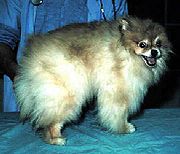
Dog Alopecia X
Veterinarian Reviewed on November 1, 2007 by Dr. Janice Huntingford
Overview
Alopecia is hair loss that does not harm the patient. Although the physiological mechanisms of Dog Alopecia X are not fully researched, this hormonal condition may have many causes, including genetic, stress, parasites or bacteria, nutrition, endocrine problems, and corticosteroids. Hair follicles may be the problem as receptors for sex hormones and growth hormones. This cosmetic condition goes by different names such as Black Skin Disease, Growth Hormone Responsive Alopecia, the Cold Funk, Castration-Responsive Dermatosis and others. Alopecia X afflicts sled dogs and other breeds including Chow Chow, Keeshond, Pomeranian, Samoyed, Alaskan Malamute, Siberian Husky, Elkhound and Miniature Poodle.
Symptoms and Diagnosis
How Alopecia X affects a dog varies from individual to individual. Hair loss may be localized or complete. Symptoms affect more males and females. While hair loss may progress rapidly on one dog, the effects may take as long as 8 years on another. Often by the age of 3 years, the dog experiences hair loss and a dry and dull coat. The longer primary hairs drop first, then the remaining fuzzy coat blows. Bald skin pigment shows. At the site of a biopsy, hair may regrow.
As yet, no single test can diagnose Dog Alopecia X. Hair loss can indicate many different conditions or diseases. Veterinarians need to rule out other diseases such as hypothyroidism, Cushing’s Disease, hyposomatotrophism, follicular dysplasia and others. Testing may include a blood panel, urinalysis, thyroid testing, adrenal hormone testing, and skin biopsy. Multiple skin biopsies on both the affected and adjacent areas can give a more thorough histology. The University of Tennessee College of Veterinary Medicine is home to an endocrinology lab that analyses adrenal sex hormone panel. An ACTH responsive test will measure sex hormones and precursors.
Treatment
Pet owners must weigh carefully the benefits and risks involved with drug therapy to treat a cosmetic condition that does not harm the dog. If a sex hormone imbalance is causing hair loss, the start of treatment can include sterilizing the dog. After this procedure, hair growth is quite common. If neutering does not result in hair regrowth, then medication may follow. Drugs may include oral melatonin, methyltestosterone, or lysodren.
Oral melatonin in 3 mg tablets has a 50% success rate in dogs after 2-3 months. If hair regrows, this treatment continues until little variation in growth occurs. The dosage gradually decreases to a weekly dose over several months. Should the hair loss recur, there is a chance that future doses of melatonin will not succeed. A side effect of melatonin may include a sedating effect. Different brands may include a wide variety in the amount of melatonin.
Methyltestosterone, an expensive drug, may cause liver damage and increase aggression. Another alternative is low dose lysodren, a chemotherapy agent that erodes the outer layer of adrenal glands and slows the production of hormones. This agent controls the cortisone produced. Side effects include possible cortisone deficiency or Addison’s Disease, an adrenal steroid deficiency. Dogs may react with listlessness, vomiting and diarrhea.
Sign up for our newsletter and receive more articles and the latest pet health updates and special offers.
Our Expert
 Dr. Janice Huntingford
Dr. Janice HuntingfordJanice Huntingford, DVM, has been in veterinary practice for over 30 years and has founded two veterinary clinics since receiving her Doctor of Veterinary Medicine at the Ontario Veterinary College, University of Guelph. She has studied extensively in both conventional and holistic modalities. Ask Dr. Jan

